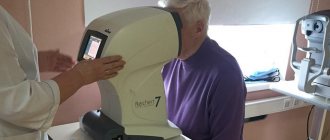Composition and release form
The composition of the drug Fotil includes two active substances:
• pilocarpine hydrochloride 20 mg per ml solution; • timolol maleate 6.84 mg per ml of solution, which corresponds to 5 mg of timolol.
Auxiliary components of the drug are necessary to create a stable solution. 0.1 mg of benzalkonium chloride, 1.12 mg of citric acid, 5.79 mg of sodium citrate, and 5 mg of hypromellose are dissolved in 1 ml of water for injection.
Fotil eye drops are a clear and colorless solution. Available in polyethylene bottles with a 5 ml dropper. The bottle and paper instructions are placed in a cardboard box.
pharmachologic effect
The pharmacological action of Fotil is due to two active components.
Pilocarpine is a sympathomimetic that acts on the parasympathetic nervous system by stimulating m-cholinergic receptors. After instillation into the conjunctival sac, Pilocarpine leads to constriction of the pupil, causes a spasm of accommodation and reduces intraocular pressure. The latter is reduced due to contraction of the iris and ciliary muscles, which leads to an increase in the angle of the anterior chamber and changes the structure of the trabecular meshwork, thereby improving the outflow of ocular fluid. The duration of action is 4-14 hours.
Pilocarpine is well absorbed through the membranes of the eyeball and penetrates into the aqueous humor, in which the maximum concentration of the drug is achieved after half an hour. The half-life is 90-150 minutes. The substance is excreted in its original form along with the intraocular fluid. Due to the fact that its production decreases when using Timolol, the rate of elimination of Pilocarpine also decreases somewhat.
Timolol is a beta blocker, that is, it prevents the binding of active substances to beta1 and beta2 adrenergic receptors. In this regard, intraocular pressure decreases due to the synthesis of fluid. Beta2 receptors, which are localized in the ciliary body, are most affected by Timolol. A decrease in pressure occurs approximately 20 minutes after instilling the solution into the eye. The peak of action occurs after 120 minutes and lasts for 24 hours. Timolol penetrates well through the membranes of the eye and quickly accumulates in the intraocular fluid of the anterior chamber. Approximately 80% of the substance is absorbed into the systemic circulation. The highest concentration of Timolol in the systemic circulation is observed 60 minutes after using the drug, and the half-life reaches 2-5 hours.
The combined use of Timolol and Pilocarpine helps reduce intraocular pressure by reducing the amount of intraocular moisture.
Pharmacological properties of the drug Etol fort
Etodolac is an NSAID derived from indoleacetic acid, which differs from other NSAIDs by the presence of a tetrahydropyranoindole core. Etodolac has anti-inflammatory, analgesic and antipyretic properties. The drug reduces the synthesis of prostaglandins from arachidonic acid by inhibiting the COX enzyme, which reduces the sensitivity of receptors to pain mediators (histamine, bradykinin), reduces exudation, migration of leukocytes, as well as the sensitivity of the hypothalamic thermoregulation centers to the action of endogenous pyrogens (interleukin-1, etc.) . Etodolac has moderate selectivity for COX-2, therefore it acts predominantly at the site of inflammation. When administered orally, etodolac is rapidly absorbed from the gastrointestinal tract. The maximum concentration in blood plasma is reached after 60 minutes and is 18 mcg/ml. Plasma protein binding is 95%, the free fraction is 1.2–4.7%. The half-life from blood plasma is about 7 hours. Etodolac is metabolized in the liver and excreted primarily by the kidneys (up to 60% in the form of metabolites).
Mode of application
The standard dosage is one drop twice a day in the affected eye only. Sometimes long-term use of Fotil is required (for several weeks) for the patient to sustainably reduce intraocular pressure. In this regard, it is necessary to carry out an objective assessment of intraocular hypertension by measuring pressure approximately one month after the start of therapy. In cases where intraocular hypertension is detected during manometry, it is recommended to replace the drug Fotil with Fotil Forte, which is more effective. It should be used in the same way as in the case of the non-extended form (1 drop 2 times a day).
Contraindications
Due to the fact that the active components of the drug can have not only local, but also systemic effects, the use of Fotil is contraindicated for:
• decrease in heart rate due to sinus bradycardia and atrioventricular blockade of 2 and 3 degrees; • anterior uveitis; • severe decompensation of heart failure and cardiogenic shock; • chronic bronchitis and bronchial asthma; • increased individual sensitivity to the constituent substances of the drops; • in the early postoperative period during eye surgery; • at an early age, since there is not enough objective data on the safety of Fotil in this age category; • for diseases of the ocular apparatus, against the background of which it is not advisable to constrict the pupil.
The use of Fotil eye drops requires caution in the following cases:
• compensated heart failure; • disorders of the blood supply to the brain; • diabetes; • decrease in blood glucose levels; • retinal disinsertion; • thyrotoxicosis; • myopia; • the period before surgery under anesthesia.
The use of the drug is possible during pregnancy and breastfeeding only if the expected benefit for the woman is greater than the possible risk for the baby.
Drugs Fotil and Fotil forte in the treatment of ophthalmic hypertension
in Primorskiy region. Melnikov V., Dogadova L. In this article we describe the eye–drops for treatment of glaucoma in Primorskiy region. More often we still use beta–blockers. For combination treatment Fotil is the most effective and comfort product. In Russia, as well as throughout the world, there is a steady trend towards an increase in the incidence of glaucoma, leading to loss of performance and disability, significant financial costs for patients and the state as a whole. All this allows us to talk about this disease as a socio-economic disease (E. S. Libman, 2002). Despite the progress achieved in the treatment of glaucoma, more than half of patients continue to lose vision (E. A. Egorov et al., 2001). Today, the following ways to prevent blindness are possible: early detection of glaucoma, lifelong medical examination, high discipline of patients regarding the fulfillment of doctor’s orders, responsibility of doctors in choosing adequate treatment - i.e. a whole range of activities that require certain financial costs (V.N. Alekseev, E.A. Egorov, V.N. Martynova, 2001). In the Primorsky Territory, 10,234 patients with primary open-angle glaucoma were identified, which is 486 people per 100 thousand population (the average for Russia is 522.7). The traditional stages of glaucoma treatment are medication, laser, and surgery. About 65% of patients in the Primorsky Territory receive drug treatment aimed at reducing intraocular pressure. In the eye department of the Regional Clinical Hospital No. 2, the dynamics of the prescription of antiglaucomatous drugs from 1999 to 2002 was monitored for 420 patients. Table 1 presents eye drops used to treat glaucoma in the Primorsky Territory. As follows from the data presented, the most widely used drugs are beta-blockers; the percentage of use of Fotil and Fotil Forte also remains high. This is explained by the convenience of their use, as well as the fact that in a number of districts and cities of the region these drugs are included in the free list. In a study of patients using Fotil for 3 years, its good tolerability was noted. At the same time, the hypotensive effect was achieved in 89% of patients, stabilization of visual functions was observed in 54% of patients. In addition, 75% of patients report satisfaction with treatment with Fotil - they have no discomfort when instilling drops, no blurred vision as a result of miosis (the drug was prescribed at night). In addition to POAG, we used Fotil in 56 patients over the age of 40 years after photorefractive keratotomy for the prevention of postoperative ocular hypertension. In no case of use of the drug in patients was there an increase in intraocular pressure. Fotil, as the drug of choice, is used in preoperative preparation before cataract extraction, as well as in the early postoperative period for the prevention of reactive hypertension. Conclusions 1. In the Primorsky Territory, beta blockers from various manufacturers are most often used for the conservative treatment of glaucoma. 2. Fotil, Fotil Forte are effective means for reducing intraocular pressure and the most convenient combination drugs for use. 3. Fotil, Fotil forte can be successfully used in the early postoperative period to correct the shape of the pupil, prevent and treat reactive ophthalmic hypertension.
Literature 1. V.N. Alekseev, E.A. Egorov, E.B. Martynova On the distribution of intraocular pressure levels in a normal population. Cl. oft. – 2001, No. 2, Page. 38–40. 2. E.A. Egorov, T.V. Stavitskaya, A.V. Kuroyedov, A.A. Khlobystov Pharmacoeconomic aspects of choosing a treatment strategy for primary open-angle glaucoma. Cl. oft. –2001, No. 4, Page. 114–116. 3. E.S. Libman, M.R. Galperin, E.E. Grishina, N.Yu. Senkevich Approaches to assessing the quality of life of ophthalmic patients. Cl. oft. – 2002, No. 3, Page. 119–122
Side effects
When using the drug Fotil, local and systemic side effects may develop.
On the part of the optical apparatus, the following may occur:
• local irritation of the eye membranes; • burning sensation and pain that quickly pass; • blurred vision; • eyelid skin dermatitis; • dry eye syndrome; • hyperemia of the conjunctiva; • spasm of the ciliary muscle and provoked myopia; • due to miosis, visual acuity may decrease in twilight lighting; • decreased sensitivity of the cornea; • punctate keratitis; • allergic inflammation of the conjunctiva.
During clinical trials, isolated cases of retinal detachment, formation of iris cysts, and iris rigidity were identified. With prolonged use of Pilocarpine, reversible changes (clouding) of the lens were detected.
Systemic manifestations include:
• dyspepsia (diarrhea, nausea); • drooling; • hypotension; • exacerbation of bronchial obstruction in asthma and bronchitis; • development of circulatory failure; • slowing of heart rate and cardiac arrhythmia; • headache in the temporal and suborbital areas; • the appearance of allergic rashes on the skin (urticaria).
Since Timolol penetrates well through the blood-brain barrier, it can affect the tissue of the central nervous system.
When used in patients with heart failure, the drug can lead to the development of asthenic syndrome, cause nausea, headache, dizziness and mental disorders (anxiety, hallucinations, depression). Very rarely, double vision, ptosis, and nasal congestion occur.
Fotil forte eye drops 40 mg+5 mg/ml 5 ml No. 1 dropper bottle
Content
Pharmacological action Indications of the drug Contraindications Side effects Interaction Method of administration and dosage Overdose Precautionary measures Special instructions Storage conditions Expiration date
pharmachologic effect
Antiglaucoma.
Timolol blocks beta-adrenergic receptors and reduces the production of intraocular fluid.
Pilocarpine stimulates m-cholinergic receptors, improves the outflow of intraocular fluid.
Indications of the drug
Open-angle and closed-angle glaucoma, glaucoma with aphakia, secondary glaucoma, marked increase in intraocular pressure (in combination with other drugs), increased intraocular pressure after eye surgery.
Contraindications
Hypersensitivity to any of the components of the drug, acute iritis, sinus bradycardia, AV block of II and III degrees, heart failure in the stage of decompensation, cardiogenic shock, bronchial asthma, severe chronic obstructive pulmonary diseases.
Use with caution in case of cerebrovascular disorders, heart failure, bronchial asthma, diabetes mellitus and hypoglycemia, thyrotoxicosis, before operations using general anesthesia.
Use during pregnancy and breastfeeding
The drug should not be used during pregnancy and breastfeeding unless the expected therapeutic effect exceeds the potential risk to the fetus.
Side effects
Local: quickly passing burning sensation and pain in the eye, increased lacrimation, redness of the conjunctiva, temporal and supraorbital headaches, myopia; associated with timolol: decreased sensitivity of the cornea, punctate keratitis, dry eye syndrome, eyelid dermatitis; possible: spasm of the ciliary muscle, induced myopia, decreased visual acuity in low light (due to miosis).
Systemic: nausea, diarrhea, increased sweating, increased salivation, decreased blood pressure, asthmatic attack, heart failure, arrhythmia.
Interaction
Drugs that disrupt the deposition of catecholamines (reserpine) contribute to the development of arterial hypotension (including orthostatic), bradycardia and dizziness.
The simultaneous use of systemic beta-blockers leads to an increase in their pharmacological effect.
Directions for use and doses
Conjunctivally. 1 drop into the affected eye 2 times a day.
If intraocular pressure remains elevated at the usual dosage, it can be increased: 1 drop of Fotil Forte 2 times a day.
Overdose
Symptoms: bradycardia, decreased blood pressure, bronchospasm and acute heart failure.
Treatment: symptomatic; administration of atropine - as an antidote to pilocarpine, isoprenaline - intravenously, to eliminate severe bradycardia or bronchospasm, dobutamine - to treat arterial hypotension.
Precautionary measures
Timolol penetrates the blood-brain barrier and affects the central nervous system, especially in overdose. Elderly patients with a history of heart failure may experience: asthenic syndrome, vomiting, dizziness, anxiety, hallucinations, headache and depression; less often - nasal congestion, diplopia, ptosis.
Several cases of retinal detachment, iris rigidity, or cyst formation in the iris have been reported in association with the use of miotic agents. Reversible lens opacification has been observed with long-term use of pilocarpine.
Symptoms of contact allergy and allergic dermatitis of the skin of the eyelids have been noted during therapy with drugs containing pilocarpine. Patients with hypersensitivity to timolol maleate may experience rashes, urticaria or allergic blepharoconjunctivitis.
The risk of developing tolerance with combined drops is less than when using drugs containing only one active substance.
Caution must be exercised when driving at night or in poor lighting.
Before instillation, contact lenses should be removed and reinserted 15 minutes after using the drug.
Safety and effectiveness in children have not been established.
special instructions
Should not be used simultaneously with other medicinal products containing beta-blockers.
The use of other eye drops should be discontinued before starting treatment with the drug. The previous antiglaucoma drug must be discontinued, and therapy with Fotil eye drops should be started the next day. Evaluation of the effectiveness of treatment should be carried out 4 weeks after the start of treatment (in some patients, tolerance may develop after a few weeks).
Treatment should be carried out with regular monitoring of intraocular pressure.
Storage conditions
At a temperature of 2–8 °C. Open bottles - at room temperature (below 25 °C), in a place protected from light.
Keep out of the reach of children.
Best before date
3 years. After opening the bottle - 1 month.
Do not use after the expiration date stated on the package.
Overdose
The most serious manifestations of overdose associated with exposure to the active components of Fotil include: • severe bradycardia and hypotension; • bronchial obstruction due to spasm of smooth muscle cells; • acute heart failure.
Treatment measures are aimed at eliminating symptoms. Atropine is an antagonist of pilocarpine and can be used as an antidote. To eliminate the symptoms of overdose, isoprenaline (for broncho-obstruction and bronchospasm) and dobutamine (for decreased systemic pressure) can be used systemically.
Interactions
When co-administered with drugs that interfere with the deposition of catecholamines (reserpine), the likelihood of developing hypotension, orthostatic hypotension, bradycardia, and dizziness increases.
With simultaneous systemic use of beta blockers and calcium channel blockers (slow), the pharmacological effect may be enhanced and the risk of arrhythmia and hypotension may increase.
The drugs quinidine and cimetidine (CYP2D6 inhibitors) help increase the plasma levels of Timolol.
Overdose of the drug Etol fort, symptoms and treatment
In case of an overdose of the drug, side effects may increase: nausea, vomiting, pain in the epigastric region, ulcers, bleeding from the gastrointestinal tract, hypernatremia, hyperkalemia, hypercreatininemia, edema, increased blood pressure, allergic interstitial nephritis, jaundice, hepatitis, bronchospasm. Treatment : you should stop taking the drug. Gastric lavage, cleansing enema or prescription of laxatives, activated carbon, and detoxification therapy are recommended. It is necessary to ensure monitoring of the activity of the respiratory and cardiovascular systems, control of hemostasis.
special instructions
The drug Fotil cannot be combined with other eye drops that contain beta blockers.
The use of other drops for the treatment of glaucoma must be stopped at least 24 hours before starting Fotil therapy. Efficacy should be assessed one month after the start of treatment, and intraocular pressure should be monitored regularly. After this, therapy should also be carried out only under the control of intraocular pressure.
Since Fotil contains benzalkonium chloride, which is a preservative, it should not be used while wearing contact lenses. Before instilling the solution, you must remove the lenses. You can return them to their original place after a quarter of an hour.
Due to the development of miosis, a temporary deterioration in visual acuity is possible, so you should not drive a vehicle or work with complex mechanisms after using Fotil.
Since Timolol can mask signs of a critical decrease in plasma glucose levels and an increase in the concentration of thyroid hormones, drops should be used with caution in patients with diabetes mellitus and thyroid pathology.
You should stop taking Fotil 48 hours before surgery under general anesthesia, as the drug may enhance the effect of systemic anesthetics and muscle relaxants.
Instructions for use ETODIN FORT
Cardiovascular diseases
When using selective COX-2 inhibitors and non-selective NSAIDs, the risk of cardiovascular thrombotic complications (myocardial infarction and stroke), which can be fatal, increases. All NSAIDs, both selective and non-selective, have this risk. To reduce adverse reactions from the cardiovascular system, use the minimum effective dose of NSAIDs whenever possible for the shortest period of time. Cardiac disorders can occur even without preliminary symptoms. There is no evidence of a reduction in cardiovascular symptoms with simultaneous use of acetylsalicylic acid. Concomitant use of acetylsalicylic acid increases the risk of developing severe adverse reactions from the digestive tract.
The use of selective COX-2 inhibitors for the treatment of pain in the first 10-14 days of coronary artery bypass grafting increases the risk of myocardial infarction.
Arterial hypertension
Taking NSAIDs, including etodolac, may lead to increased blood pressure or worsening of pre-existing hypertension, which may contribute to adverse reactions from the cardiovascular system. Patients who take thiazide and loop diuretics concomitantly with etodolac may experience a decrease in the effect of the latter. Blood pressure should be monitored while taking NSAIDs.
Chronic heart failure and edema
Patients taking NSAIDs experience fluid retention and swelling. Etodolac should be used with caution in patients with fluid retention or heart failure.
Effect on the digestive tract
Taking NSAIDs, including etodolac, can cause severe adverse reactions from the digestive tract, including inflammation, bleeding, ulcers or perforation of the stomach or intestines, which can be fatal. NSAIDs should be used with caution in patients with a history of peptic ulcers or gastrointestinal bleeding. Other risk factors that increase the risk of gastrointestinal bleeding include concomitant use of oral corticosteroids, anticoagulants, long-term use of NSAIDs, smoking, alcohol intake, advanced age, and severe general condition. Most spontaneous reports were recorded in elderly and debilitated patients. To reduce the potential risk of adverse reactions from the digestive tract, use the lowest effective doses possible for the shortest period of time. Physicians and patients should be aware of the symptoms of gastrointestinal bleeding and ulcers when treating NSAIDs, and if adverse reactions are suspected, the patient should be assessed, the drug discontinued, and appropriate measures taken.
Effect on the kidneys
Long-term use of NSAIDs can lead to the development of papillary necrosis and other kidney damage. Renal prostaglandins play a compensatory role in maintaining renal perfusion. Patients using NSAIDs may experience a dose-dependent decrease in prostaglandin formation, which contributes to the development of renal failure. Risk factors for the development of these reactions include impaired renal and/or liver function, heart failure, use of diuretics and ACE inhibitors, and old age. Stopping NSAIDs usually results in a return to the previous condition.
There is no information on the use of etodolac in patients with progressive renal failure, therefore it is not recommended to use etodolac in patients in this category. Renal function should be examined before starting treatment with etodolac.
Anaphylactoid reactions
As with other NSAIDs, patients taking etodolac may experience anaphylactoid reactions without a history of them. Etodolac should not be prescribed to patients with the aspirin triad (polypous rhinosinusitis, bronchospasm attacks and intolerance to NSAIDs). Deaths have occurred in such patients.
Skin reactions
NSAIDs, including etodolac, can cause severe skin reactions such as exfoliative dermatitis, Stevens-Johnson syndrome and toxic epidermal necrolysis, sometimes fatal. These severe reactions may occur without warning. Patients should be informed of the symptoms of severe skin manifestations. If skin rashes or any other manifestation of hypersensitivity reactions occur, use of the drug should be discontinued.
Effect on the liver
When taking etodolac, there is an increase in the activity of liver enzymes. Laboratory changes may progress, remain unchanged, or decrease after discontinuation of therapy. A significant increase in ALT and AST (about 3 or more times) was observed in 15% of patients during clinical studies of NSAIDs. Rare cases of severe liver reactions have been reported, including jaundice and fulminant hepatitis with a fatal outcome, liver necrosis, liver failure, sometimes with a fatal outcome. If clinical symptoms of renal dysfunction develop, systemic manifestations (eosinophilia, skin rashes) are possible, in which case the use of etodolac should be discontinued.
Effect on blood
Anemia sometimes occurs with the use of NSAIDs, including etodolac. This can be observed due to fluid retention, as a result of gastrointestinal bleeding, and impaired erythropoiesis. In patients with long-term use of NSAIDs, including etodolac, hemoglobin and hematocrit levels should be monitored. NSAIDs inhibit platelet aggregation and prolong bleeding time in some patients. Compared to acetylsalicylic acid, the effect on platelets is significantly smaller or less durable. Platelet levels should be monitored in patients taking etodolac as coagulation disorders may occur, especially in patients taking anticoagulants.
Bronchial asthma
Patients with bronchial asthma may develop bronchospasm. The use of acetylsalicylic acid for aspirin-induced asthma causes severe bronchospasm. Due to the possibility of a cross-reaction, the drug should not be used in patients who have a history of asthma, rhinitis, or urticaria during treatment with other NSAIDs.
Other Cautions
Etodolac is not a substitute for corticosteroids for adrenal insufficiency. In patients with long-term use of corticosteroids, the latter should be withdrawn gradually.
The drug contains lactose, so it should not be used in cases of hereditary galactose intolerance, lapp lactase deficiency or glucose-galactose malabsorption disorder.
Like other NSAIDs, etodolac may inhibit platelet function, especially in patients taking anticoagulants. In this case, patients should be under medical supervision. In case of bleeding, treatment is stopped.
In patients with heart failure, chronic hepatic or renal failure, liver cirrhosis, as well as in elderly patients, renal and liver function should be monitored (at least once a month).
Patients with SLE and systemic connective tissue diseases have an increased risk of non-infectious meningitis.
Etodolac can weaken a woman's reproductive function. Patients undergoing research for infertility should discontinue the drug.
Impact on the ability to drive vehicles and operate machinery
The patient should be warned that taking the drug may cause dizziness, general weakness, and visual impairment. While taking the drug, you must be careful when driving vehicles or other machinery. If these reactions develop, it is necessary to refrain from driving vehicles and working with moving mechanisms.





